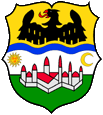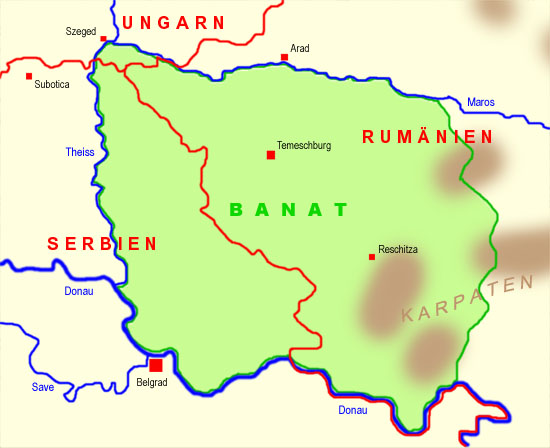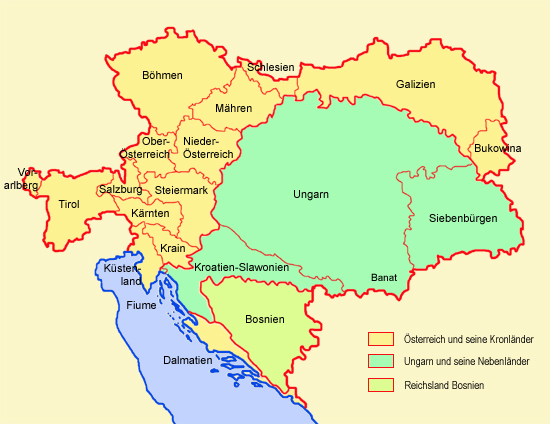mobile View, to the German Version tap the flag


- Banat, or: Banat of Temesch
- historical region between Romania, Serbia and Hungary
- own names: Romanian: Banat, Serbian: Banat, German: Banat, Hungarian: Bánság
• Flag
• Coat of Arms
• Meaning/Origin of the Coat of Arms
• Map
• Numbers and Facts
• History
• Origin of the Country's Name
The Banat had probably never owned an own flag. There are as well none typical colours of the country (Landesfarben). The in the year 1918 proclaimed "Republic of Banat" probably had a flag, but that is not well handed down.
Source, by: Flags of the World


1718–1779,
Coat of arms of Banat,
Source:
www.banater-aktualitaet.de

Heraldry of the Romanian Banat,
Source:
www.banater-aktualitaet.de

Coat of arms of the Banat Suebians,
Source:
http://lux.fh-reutlingen.de/banat

The Banat has today no own coat of arms anymore. The first and last consistent coat of arms for the whole Banat is the coat of arms as crown land (Kronland) of the Habsburg monarchy. The coat of arms was valid between 1718 and 1779 and has its roots partially in the coat of arms of the capital Temeshburg. It shows a tower with battlements, in it a closed gate, to the left and on the right of it stockades and in the foreground a morass. The prince's hat above the scutcheon exemplifys the status of the country as an inheritable land (Kronland) of the imperium. It symbolizes the in the history of the country frequent repulse of invaders and the severe state of the country after the Turkish era. After the handover to Hungary the country was partitioned in three comitates (districts) and every comitate became awarded an own coat of arms. Important is the coat of arms of the Comitate of Temesh (Temeshburg), because it showed among others two heraldic elements which are walid until today: the Fortress of Temeshburg and a straightening golden lion which holds a curved sword in its rised paw.
In result of the First World War the Banat of Temesh became partitioned between Romania, Serbia and Hungary. The Romanian part was partitioned in two districts: Temesh (Timis) and Severin. The coat of arms of Temesh shows again and among others the Fortress of Temeshburg a straightening golden lion which holds a curved sword in its rised paw. On the coat of arms of Severin is among others to see a golden bridge over blue water. This bridge over the Danube River was build near Seberin by the troops of Trajan – the Roman General and Emperor. The shield of the Romanian coat of arms was in 1921 added by the acquisitions of the First World War : Banat and Siebenburgen. The Banat was (and is since 1992 again) represented by the Trajan Bridge and the golden lion with the curved sword.
The at Hungary remained part of the Banat was locked to the Comitate of Csongrád.
The Serbian parts of the Banat were joined with Sirmia and the Batshka to the Province of Vojvodina. The coat of arms of the Vojvodina shows in one of its tree fields the golden lion with the curved sword.
The once in the Banat living Germans (Banat Suebians) created in 1950 an own coat of arms for their nation. It shows in the upper part a part of the eagle of the empire and remembers the descent, a blue wave-line in the middle represents the Danube River, and in the lower part is to see the Fortress of Temeshburg with sun and moon.
Source: www.banater-aktualitaet.de,
http://lux.fh-reutlingen.de/banat,
Volker Preuss

The Division of the Banat:

Map: Volker Preuss
Position of the Banat in Austria-Hungary:

Map: Volker Preuss

Area: 10.990 square miles, thereof nowadays 7.314 sq.mi. in Romania, 3.593 sq.mi. in Serbia, 84 sq.mi. in Hungary
Inhabitants: ca. 3.400.000 (2012), to 1944 lived here: 37% Romanians, 25% Germans, 18% Serbs, 15% Hungarians, 5% Slovaks, Croats, Ukrainians, Armenians, Italians and Spaniards
Density of Population: ca. 422 inh./sq.mi.
Historical centre: Temeschburg (rum.: Timisoara, ung.: Temesvár), 319.279 inh. (2011)
Languages: Romanian, Serbian, Hungarian, German
Currency: per part of the country Romanian, Serbian or Hungarian Currency
Time Zone:
A.) in the Serbian-Hungarian part: GMT + 1 h,
B.) in the Romanian part: GMT + 2 h
Source: Wikipedia (D),
RetroBib Retrobibliothek

antiquity · the Banat is a part of Dacia
106 · the Roman Emperor and General Trajan conquers Dakia, incorporation into the Roman Empire as Province of Dacia
270 · the Roman troops retreat from Dacia
271/272 · the Roman Emperor Aurelian cedes Dacia officially to the Western Goth
441 · the Huns range Dacia and submit it
453 · death of Attila, the King of the Huns
454 · withdrawal of the Huns, the Banat becomes a part of the Empire of the Gepides
567 · Langobards and Awars conquer the Empire of the Gepides, settlement by Awars
6th century · immigration of Slavs
800 · annihilation of the Empire of the Awares by Carl the Great, Dacia is temporary ruled by Bulgarians
869–900 · take of land by the Hungarians
950–1000 · in the Banat exists the Principality of Chanád under Prince Akhtum
1000 · Siebenburgen (Transsilvania) and the Banat come under Hungarian control
11th–13th century · invasions of the Tatars and Mongols, repeated devastation of the Banat
1521 · conquest and devastation of the Banat by 40.000 man of the Ottoman Empire (Turkey) under Mehemed Hyde
20th of July 1552 · conquest of Temeshburg by Ottoman troops, the Banat becomes transformed in a Turkish Sandjak (Sandjak = province under a pasha with two steed-tails [Beglerbeg]), escape of the christian population to Moldavia, Walachia and to Siebenburgen, desolation of the Banat
1716–1718 · Turk's War: Habsburg (Austria) against the Ottoman Empire, 1716 conquest of Temeschburg by imperial troops under Prince Eugen, 1717 fall of Belgrad
21st of July 1718 · Peace of Passarowitz (Pozarevac), the Ottoman Empire cedes the Banat, the Small Walachia and Northern Serbia to the House of Habsburg, the Banat becomes subordinated under the direct administration of the emperor as Banat of Temesch and becomes populated by Germans and was made fertile again
1779 · annexation to Hungary, division in thre Komitats (Districts)
1848–1849 · confusions of revolution, civil war, Hungarians and Germans defend the Banat against Serbian plunderers
31st of October 1918 · proclamation of the "Banat Republic" on the occasion of the collapse of the Habsburg Monarchy and of Austria-Hungary, few days later forcibly terminated by Serbian troops
4th of June 1920 · Peace of Trianon, division of the Banat: eastern part with Temeschburg to Romania, western part to Serbia, a small residual area remains at Hungary
1944 · expulsion, kidnapping and assassination of the largest part of the German population (ca. 200.000 persons) out of the Serbian Western Banat, in the Romanian Eastern Banat in a significant lower volume
1970–1995 · nearly all the in the (Romanian) Banat living Germans leave the Banat
Source: Wikipedia (D),
RetroBib Retrobibliothek,
Deutschlands Gebietsverluste,
Volker Preuss

The name "Banat" characterized Hungarian frontier-provinces which were administered by a functionary with the title "Ban". After the wars against the Turks there was only one of those Banats, the Banat of Temesvár (Temeschburg), which received its name on the occasion of the peace of Passarowitz, however there was never one "Ban".
Source: RetroBib Retrobibliothek


![]()






